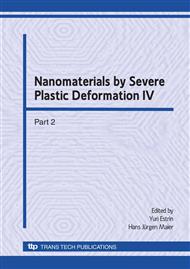p.452
p.458
p.464
p.470
p.475
p.481
p.487
p.493
p.501
Effect of Nanocrystalline Structure and Polygonized Dislocation Substructure on Ti-Ni Martensite Lattice Parameters and Transformation Lattice Strain
Abstract:
The Ti-50.26 and 50.61at.%Ni alloys were cold-rolled with true strains from e=0.3 to 2.1. Post-deformation annealing in the 200 to 500°C temperature range after a moderate deformation (e=0.3) produced a polygonized dislocation substructure with various dislocation density and subgrain size, while after severe plastic deformation (e=1.7-1.9), a nanocrystalline structure with various grain size was formed in the B2-austenite. An X-ray diffraction study shows that lattice parameters of B19'-martensite formed from (a) partially recovered and polygonized or (b) nanocrystalline austenites differ from the corresponding parameters of the martensite formed from quenched (recrystallized) austenite. This difference increases with nanocrystalline grain refinement and with an increase in residual dislocation density and subgrain refinement. The maximum martensitic transformation strain has the highest value for the martensite formed in recrystallized austenite, and this value decreases with nanograin refinement and with an increase in dislocation density and subgrain refinement.
Info:
Periodical:
Pages:
475-480
Citation:
Online since:
June 2008
Price:
Сopyright:
© 2008 Trans Tech Publications Ltd. All Rights Reserved
Share:
Citation:


